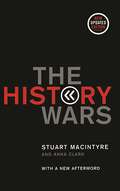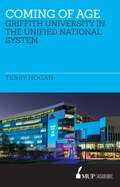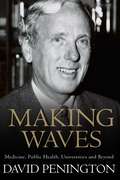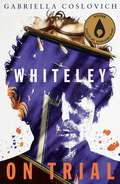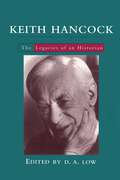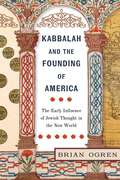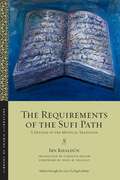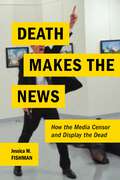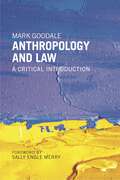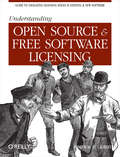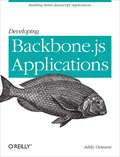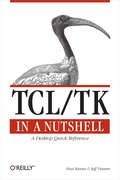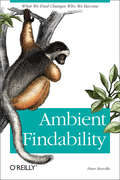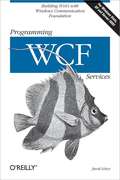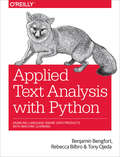- Table View
- List View
Making Headlines
by Chris MitchellAs editor-in-chief of The Australian, Chris Mitchell ran the largest stable of journalists with the largest editorial budget in the country for more than twelve years. This entertaining and deeply revealing book offers readers riveting insights into the quirks and foibles of some of the most powerful politicians and media executives this country has produced. A controversial figure throughout his quarter of a century as a daily editor, Chris Mitchell still maintains close regular contact with past prime ministers, editors and media CEOs. Making Headlines highlights the judgements and thinking that govern daily newspaper journalism at the highest level and the battles fought to publish tough stories about the rich and the powerful, the disenfranchised and the powerless. Making Headlines is compulsory reading for citizens who care, the political class inside the beltway and beyond, and wannabe journalists in search of a job.
History Wars
by Stuart Macintyre Anna ClarkThe nation's history has probably never been more politicised than it is today. Politicians, journalists, columnists, academics and Australians from all walks of life argue passionately — and often, ideologically — about the significance of the national story: the cherished ideal of the 'fair go', the much contested facts of Indigenous dispossession, the Anzac legend, and the nation's strategic alliance with the United States. Historians have become both combatants and casualties in this war of words. In The History Wars, Stuart Macintyre and Anna Clark explore how this intense public debate has polarised the nation and paralysed history departments. This edition includes a new afterword by Stuart Macintyre which recounts, with rueful irony, the outbreak of controversy that followed the book's original publication, and the further light it shed on the uses and abuses of Australian history.
Backyard Insects Updated Edition
by Paul Horne Denis CrawfordLove them or loathe them, we can't avoid insects.From aphids to flies, ladybirds to wasps, insects of all shapes and sizes share our homes and gardens. Now in updated edition, the bestselling Backyard Insects explores the secrets and habits of more than one hundred little critters that are common to backyard Australia. Crawling with full-colour, larger-than-life photographs for easy identification, Backyard Insects is an indispensable guide for nature lovers, gardeners and kids of all ages.
Coming of Age: Griffith University in the Unified National System
by Terry HoganIn December 1987 John Dawkins, the Australian Government Minister for Employment, Education and Training released a Green Paper that foreshadowed major changes in the tertiary education sector through the formation of a Unified National System. This was 16 years after the establishment of Griffith University and only 12 years since the admission of Griffith's first undergraduate students. Dawkins' ideas presented Griffith University with a dilemma: whether to continue being different from other Australian universities-a boutique institution committed to 'the Griffith way' in pedagogy with a relatively small student enrolment and academic profile-or to become more like its academic peers and embrace growth and diversity. In only three years Griffith amalgamated with other academic institutions to become a multi-campus university, while still retaining some of its founding characteristics. Griffith emerged from the changes as a large and complex institution, different in ways that its founders could not have imagined. Coming of Age traces the impact on Griffith University of the creation of the Unified National system.
Making Waves: Medicine, Public Health, Universities and Beyond
by David PeningtonThroughout his academic and medical careers, David Penington has been an agent of change. In his fascinating memoirs, one of Australia's leading public health experts and the former Vice Chancellor of the University of Melbourne reveals his ethos, drives and the highs and lows of a life built on making waves. Appointed at St Vincent's Hospital in Melbourne, he fostered new medical research specialty areas in haematology, medical oncology, endocrinology, gastroenterology and later neurology, and renal disease--a strategic development for a public hospital in the early 1970s. At the University of Melbourne, he was Professor and then Dean of the Faculty of Medicine, before becoming Vice Chancellor in 1988. During his tenure, he strongly resisted major and damaging government intrusion into the operations of universities, all the while reforming the education, research and management practices at the University of Melbourne. He has been at the forefront of national public health policy for more than twenty years, including four years chairing the National AIDS Task Force for the Hawke government. In 1984 he was Chair of the National Committee of Inquiry into a dispute between the government and the medical profession over public hospitals, which was key to the implementation of the Medicare system. He has also led two inquiries into illicit drug policies. Making Waves details a tireless leader who at every stage of his working life has never shunned public controversy in a bid to improve the lives of all Australians.
Whiteley on Trial
by Gabriella CoslovichIt was a cause c�l�bre: the biggest case of alleged art fraud to come before the Australian criminal justice system, a $4.5 million sting drawing in one of the country's most gifted and ultimately tragic artists, Brett Whiteley, a heroin addict who died alone in 1992.It started with suspicions raised about artworks being produced in the style of Whiteley in a Melbourne art restorer's studio. Secret photographs were taken as the paintings took form.A jury finds two men guilty of faking Whiteleys, but a year later the appeal bench sensationally acquits them. The paintings are returned to their owners, leaving the legitimacy of the artworks in limbo. Whiteley on Trial investigates this remarkable case and exposes the avarice of the art world, the disdain for connoisseurship and the fragility of authenticity.
Keith Hancock: The Legacies of an Historian
by D.A. LowSir Keith Hancock KBE (1898-1984) was the most distinguished scholar in the humanities and social sciences to have been born and to have worked in Australia. He was a graduate of the University of Melbourne, a Rhodes Scholar and the first Australian Fellow of All Souls College, Oxford. He successively held History chairs at the universities of Adelaide, Birmingham, Oxford and London and at the Australian National University. Aged 32 he published his Australia (London, 1930), still the single most striking commentary on this country, many of whose aphorisms have percolated through into numerous other writings. Aged 74 he published his last major work, Discovering Monaro: A Study of Man's Impact on the Environment (Cambridge, 1972), which was arguably the primary fillip to the study of Australian environmental history to this day. The main chapters of this book discuss, largely in sequence, the major books that he wrote, the fields with which he dealt, and the directions these have taken since he did so. They revisit an extraordinary series of creative achievements while providing an introduction to the work of an exceptional Australian scholar. The book will be important for anyone interested in the Humanities in Australia, and particularly for those concerned with Australian historiography. There are indications that imaginative teachers of History Honours students are already 'going back' to Hancock's writing and finding students responding positively to it.
Kabbalah and the Founding of America: The Early Influence of Jewish Thought in the New World
by Brian OgrenExplores the influence of Kabbalah in shaping America’s religious identityIn 1688, a leading Quaker thinker and activist in what is now New Jersey penned a letter to one of his closest disciples concerning Kabbalah, or what he called the mystical theology of the Jews. Around that same time, one of the leading Puritan ministers developed a messianic theology based in part on the mystical conversion of the Jews. This led to the actual conversion of a Jew in Boston a few decades later, an event that directly produced the first kabbalistic book conceived of and published in America. That book was read by an eventual president of Yale College, who went on to engage in a deep study of Kabbalah that would prod him to involve the likes of Benjamin Franklin, and to give a public oration at Yale in 1781 calling for an infusion of Kabbalah and Jewish thought into the Protestant colleges of America.Kabbalah and the Founding of America traces the influence of Kabbalah on early Christian Americans. It offers a new picture of Jewish-Christian intellectual exchange in pre-Revolutionary America, and illuminates how Kabbalah helped to shape early American religious sensibilities. The volume demonstrates that key figures, including the well-known Puritan ministers Cotton Mather and Increase Mather and Yale University President Ezra Stiles, developed theological ideas that were deeply influenced by Kabbalah. Some of them set out to create a more universal Kabbalah, developing their ideas during a crucial time of national myth building, laying down precedents for developing notions of American exceptionalism. This book illustrates how, through fascinating and often surprising events, this unlikely inter-religious influence helped shape the United States and American identity.
Jews Across the Americas: A Sourcebook, 1492–Present (Goldstein-Goren Series in American Jewish History)
by Adriana M. Brodsky and Laura Arnold LeibmanAn overview of the history of American Jewry using primary sources from Latin America, theCaribbean, Canada, and the United StatesJews Across the Americas is a groundbreaking sourcebook capturing the historical diversity and culturalbreadth of American Jews across Latin America, the Caribbean, Canada, and the United States. Featuringprimary documents as well as scholarly interpretations, Jews Across the Americas builds upon newdevelopments in Jewish Studies, engaging with transnationalism, race, sexuality, and gender, andhighlighting the lived experiences of those often left out of Jewish history.Jews Across the Americas features an impressively broad and far-reaching range of historical sources,including artifacts and objects that have not previously been featured as integral to Jewish history in theWestern hemisphere. Entries teach readers how to understand everything from wills andadvertisements to sermons, and how to interpret photographs, domestic architecture, and comics.Whether it’s a recipe from Brazil that blends Moroccan and Amazonian foodways, or a text about thefirst non-binary Jew to cross the Atlantic in the eighteenth century, each entry broadens ourunderstanding of Jewish American history.
Signs of Disability (Crip #4)
by Stephanie L. KerschbaumHow can we learn to notice the signs of disability?We see indications of disability everywhere: yellow diamond-shaped “deaf person in area” road signs, the telltale shapes of hearing aids, or white-tipped canes sweeping across footpaths. But even though the signs are ubiquitous, Stephanie L. Kerschbaum argues that disability may still not be perceived due to a process she terms “dis-attention.”To tell better stories of disability, this multidisciplinary work turns to rhetoric, communications, sociology, and phenomenology to understand the processes by which the material world becomes sensory input that then passes through perceptual apparatuses to materialize phenomena—including disability. By adding perception to the understanding of disability’s materialization, Kerschbaum significantly expands our understanding of disability, accounting for its fluctuations and transformations in the semiotics of everyday life.Drawing on a set of thirty-three research interviews focused on disabled faculty members’ experiences with disability disclosure, as well as written narratives by disabled people, this book argues for the materiality of narrative, suggesting narratives as a means by which people enact boundaries around phenomena and determine their properties. Signs of Disability offers strategies and practices for challenging problematic and pervasive forms of “dis-attention” and proposes a new theoretical model for understanding disability in social, rhetorical, and material settings.
"Jesus Saved an Ex-Con": Political Activism and Redemption after Incarceration (Religion and Social Transformation #9)
by Edward Orozco FloresAn examination of the efforts of faith-based organizations to expand the rights of the formerly incarcerated The use of religion to rehabilitate and redeem formerly incarcerated individuals has been a cultural touchstone of the modern era. Yet religious outreach to those with criminal records has typically been associated with an emphasis on private spirituality, with efforts focused on repentance, conversion, and restorative justice. This book sheds light on how faith-based organizations utilize the public arena, mobilizing to expand the social and political rights of former inmates. In “Jesus Saved an Ex-Con,” Edward Orozco Flores profiles Community Renewal Society and LA Voice, two faith-based organizations which have actively waged community organizing campaigns to expand the rights of people with records. He illuminates how these groups help the formerly incarcerated re-enter broader communities through the expansion of citizenship rights and participation in civic engagement. Most work on prisoner reentry has focused on how the behavior of those with records may be changed through interventions, rather than considering how those with records may change the society that receives them. Flores explores how the formerly incarcerated use redemption scripts to participate in civic engagement, to remove the felony conviction question from employment applications and to restrict the use of criminal background checks in housing and employment. He shows that people with records can redeem themselves while also challenging and changing the way society receives them.
The Requirements of the Sufi Path: A Defense of the Mystical Tradition (Library of Arabic Literature #103)
by Ibn KhaldūnSufism through the eyes of a legal scholarIn The Requirements of the Sufi Path, the renowned North African historian and jurist Ibn Khaldūn applies his analytical powers to Sufism, which he deems a bona fide form of Islamic piety. Ibn Khaldūn is widely known for his groundbreaking work as a sociologist and historian, in particular for the Muqaddimah, the introduction to his massive universal history. In The Requirements of the Sufi Path, he writes from the perspective of an Islamic jurist and legal scholar. He characterizes Sufism and the stages along the Sufi path and takes up the question of the need for a guide along that path. In doing so, he relies on the works of influential Sufi scholars, including al-Qushayrī, al-Ghazālī, and Ibn al-Khaṭīb. Even as Ibn Khaldūn warns of the extremes to which some Sufis go—including practicing magic—his work is essentially a legal opinion, a fatwa, asserting the inherent validity of the Sufi path.The Requirements of the Sufi Path incorporates the wisdom of three of Sufism’s greatest voices as well as Ibn Khaldūn’s own insights, acquired through his intellectual encounters with Sufism and his broad legal expertise. All this he brings to bear on the debate over Sufi practices in a remarkable work of synthesis and analysis.An English-only edition.
Disrupting Dignity: Rethinking Power and Progress in LGBTQ Lives (LGBTQ Politics)
by Stephen M. Engel Timothy S. LyleWhy LGBTQ+ people must resist the seduction of dignityIn 2015, when the Supreme Court declared that gay and lesbian couples were entitled to the “equal dignity” of marriage recognition, the concept of dignity became a cornerstone for gay rights victories. In Disrupting Dignity, Stephen M. Engel and Timothy S. Lyle explore the darker side of dignity, tracing its invocation across public health politics, popular culture, and law from the early years of the HIV/AIDS crisis to our current moment. With a compassionate eye, Engel and Lyle detail how politicians, policymakers, media leaders, and even some within LGBTQ+ communities have used the concept of dignity to shame and disempower members of those communities. They convincingly show how dignity—and the subsequent chase to be defined by its terms—became a tool of the state and the marketplace thereby limiting its more radical potential. Ultimately, Engel and Lyle challenge our understanding of dignity as an unquestioned good. They expose the constraining work it accomplishes and the exclusionary ideas about respectability that it promotes. To restore a lost past and point to a more inclusive future, they assert the worthiness of queer lives beyond dignity’s limits.
Locked Out: Regional Restrictions in Digital Entertainment Culture (Critical Cultural Communication #14)
by Evan ElkinsA rare insight into how industry practices like regional restrictions have shaped global media culture in the digital era “This content is not available in your country.” At some point, most media consumers around the world have run into a message like this. Whether trying to watch a DVD purchased during a vacation abroad, play an imported Japanese video game, or listen to a Spotify library while traveling, we are constantly reminded of geography’s imprint on digital culture. We are locked out. Despite utopian hopes of a borderless digital society, DVDs, video games, and streaming platforms include digital rights management mechanisms that block media access within certain territories. These technologies of “regional lockout” are meant first and foremost to keep the entertainment industries’ global markets distinct. But they also frustrate consumers and place territories on a hierarchy of global media access. Drawing on extensive research of media-industry strategies, consumer and retailer practices, and media regulation, Locked Out explores regional lockout’s consequences for media around the globe. Power and capital are at play when it comes to who can consume what content and who can be a cultural influence. Looking across digital technologies, industries, and national contexts, Locked Out argues that the practice of regional lockout has shaped and reinforced global hierarchies of geography and culture.
Death Makes the News: How the Media Censor and Display the Dead
by Jessica M. FishmanWinner of the 2018 Media Ecology Association's Erving Goffman Award for Outstanding Scholarship in the Ecology of Social InteractionWinner of the Eastern Communication Association's Everett Lee Hunt AwardA behind-the-scenes account of how death is presented in the mediaDeath is considered one of the most newsworthy events, but words do not tell the whole story. Pictures are also at the epicenter of journalism, and when photographers and editors illustrate fatalities, it often raises questions about how they distinguish between a “fit” and “unfit” image of death.Death Makes the News is the story of this controversial news practice: picturing the dead. Jessica Fishman uncovers the surprising editorial and political forces that structure how the news and media cover death. The patterns are striking, overturning long-held assumptions about which deaths are newsworthy and raising fundamental questions about the role that news images play in our society.In a look behind the curtain of newsrooms, Fishman observes editors and photojournalists from different types of organizations as they deliberate over which images of death make the cut, and why. She also investigates over 30 years of photojournalism in the tabloid and patrician press to establish when the dead are shown and whose dead body is most newsworthy, illustrating her findings with high-profile news events, including recent plane crashes, earthquakes, hurricanes, homicides, political unrest, and war-time attacks. Death Makes the News reveals that much of what we think we know about the news is wrong: while the patrician press claims that they do not show dead bodies, they are actually more likely than the tabloid press to show them—even though the tabloids actually claim to have no qualms showing these bodies. Dead foreigners are more likely to be shown than American bodies. At the same time, there are other unexpected but vivid patterns that offer insight into persistent editorial forces that routinely structure news coverage of death. An original view on the depiction of dead bodies in the media, Death Makes the News opens up new ways of thinking about how death is portrayed.
Anthropology and Law: A Critical Introduction
by Mark GoodaleAn introduction to the anthropology of law that explores the connections between law, politics, and technologyFrom legal responsibility for genocide to rectifying past injuries to indigenous people, the anthropology of law addresses some of the crucial ethical issues of our day. Over the past twenty-five years, anthropologists have studied how new forms of law have reshaped important questions of citizenship, biotechnology, and rights movements, among many others. Meanwhile, the rise of international law and transitional justice has posed new ethical and intellectual challenges to anthropologists. Anthropology and Law provides a comprehensive overview of the anthropology of law in the post-Cold War era. Mark Goodale introduces the central problems of the field and builds on the legacy of its intellectual history, while a foreword by Sally Engle Merry highlights the challenges of using the law to seek justice on an international scale. The book’s chapters cover a range of intersecting areas including language and law, history, regulation, indigenous rights, and gender. For a complete understanding of the consequential ways in which anthropologists have studied, interacted with, and critiqued, the ways and means of law, Anthropology and Law is required reading.
Understanding Open Source and Free Software Licensing: Guide to Navigating Licensing Issues in Existing & New Software
by Andrew M. St. LaurentIf you've held back from developing open source or free software projects because you don't understand the implications of the various licenses, you're not alone. Many developers believe in releasing their software freely, but have hesitated to do so because they're concerned about losing control over their software. Licensing issues are complicated, and both the facts and fallacies you hear word-of-mouth can add to the confusion.Understanding Open Source and Free Software Licensing helps you make sense of the different options available to you. This concise guide focuses on annotated licenses, offering an in-depth explanation of how they compare and interoperate, and how license choices affect project possibilities. Written in clear language that you don't have to be a lawyer to understand, the book answers such questions as: What rights am I giving up? How will my use of OS/FS licensing affect future users or future developers? Does a particular use of this software--such as combining it with proprietary software--leave me vulnerable to lawsuits?Following a quick look at copyright law, contracts, and the definition of "open source," the book tackles the spectrum of licensing, including:The MIT (or X), BSD, Apache and Academic Free licensesThe GPL, LGPL, and Mozilla licensesThe QT, Artistic, and Creative Commons licensesClassic Proprietary licensesSun Community Source license and Microsoft Shared Source projectThe book wraps up with a look at the legal effects--both positive and negative--of open source/free software licensing.Licensing is a major part of what open source and free software are all about, but it's still one of the most complicated areas of law. Even the very simple licenses are tricky. Understanding Open Source and Free Software Licensing bridges the gap between the open source vision and the practical implications of its legal underpinnings. If open source and free software licenses interest you, this book will help you understand them. If you're an open source/free software developer, this book is an absolute necessity.
Developing Backbone.js Applications: Building Better JavaScript Applications (Oreilly And Associate Ser.)
by Addy OsmaniIf you want to build your site’s frontend with the single-page application (SPA) model, this hands-on book shows you how to get the job done with Backbone.js. You’ll learn how to create structured JavaScript applications, using Backbone’s own flavor of model-view-controller (MVC) architecture.Start with the basics of MVC, SPA, and Backbone, then get your hands dirty building sample applications—a simple Todo list app, a RESTful book library app, and a modular app with Backbone and RequireJS. Author Addy Osmani, an engineer for Google’s Chrome team, also demonstrates advanced uses of the framework.Learn how Backbone.js brings MVC benefits to the client-sideWrite code that can be easily read, structured, and extendedWork with the Backbone.Marionette and Thorax extension frameworksSolve common problems you’ll encounter when using Backbone.jsOrganize your code into modules with AMD and RequireJSPaginate data for your Collections with the Backbone.Paginator pluginBootstrap a new Backbone.js application with boilerplate codeUse Backbone with jQuery Mobile and resolve routing problems between the twoUnit-test your Backbone apps with Jasmine, QUnit, and SinonJS
Tcl/Tk in a Nutshell: A Desktop Quick Reference
by Jeff Tranter Paul RainesThe Tcl language and Tk graphical toolkit are simple and powerful building blocks for custom applications. The Tcl/Tk combination is increasingly popular because it lets you produce sophisticated graphical interfaces with a few easy commands, develop and change scripts quickly, and conveniently tie together existing utilities or programming libraries.One of the attractive features of Tcl/Tk is the wide variety of commands, many offering a wealth of options. Most of the things you'd like to do have been anticipated by the language's creator, John Ousterhout, or one of the developers of Tcl/Tk's many powerful extensions. Thus, you'll find that a command or option probably exists to provide just what you need.And that's why it's valuable to have a quick reference that briefly describes every command and option in the core Tcl/Tk distribution as well as the most popular extensions. Keep this book on your desk as you write scripts, and you'll be able to find almost instantly the particular option you need.Most chapters consist of alphabetical listings. Since Tk and mega-widget packages break down commands by widget, the chapters on these topics are organized by widget along with a section of core commands where appropriate. Contents include:Core Tcl and Tk commands and Tk widgetsC interface (prototypes)Expect[incr Tcl] and [incr Tk]TixTclXBLTOratcl, SybTcl, and Tclodbc
Ambient Findability: What We Find Changes Who We Become
by Peter MorvilleHow do you find your way in an age of information overload? How can you filter streams of complex information to pull out only what you want? Why does it matter how information is structured when Google seems to magically bring up the right answer to your questions? What does it mean to be "findable" in this day and age? This eye-opening new book examines the convergence of information and connectivity. Written by Peter Morville, author of the groundbreaking Information Architecture for the World Wide Web, the book defines our current age as a state of unlimited findability. In other words, anyone can find anything at any time. Complete navigability.Morville discusses the Internet, GIS, and other network technologies that are coming together to make unlimited findability possible. He explores how the melding of these innovations impacts society, since Web access is now a standard requirement for successful people and businesses. But before he does that, Morville looks back at the history of wayfinding and human evolution, suggesting that our fear of being lost has driven us to create maps, charts, and now, the mobile Internet.The book's central thesis is that information literacy, information architecture, and usability are all critical components of this new world order. Hand in hand with that is the contention that only by planning and designing the best possible software, devices, and Internet, will we be able to maintain this connectivity in the future. Morville's book is highlighted with full color illustrations and rich examples that bring his prose to life.Ambient Findability doesn't preach or pretend to know all the answers. Instead, it presents research, stories, and examples in support of its novel ideas. Are we truly at a critical point in our evolution where the quality of our digital networks will dictate how we behave as a species? Is findability indeed the primary key to a successful global marketplace in the 21st century and beyond. Peter Morville takes you on a thought-provoking tour of these memes and more -- ideas that will not only fascinate but will stir your creativity in practical ways that you can apply to your work immediately."A lively, enjoyable and informative tour of a topic that's only going to become more important."--David Weinberger, Author, Small Pieces Loosely Joined and The Cluetrain Manifesto"I envy the young scholar who finds this inventive book, by whatever strange means are necessary. The future isn't just unwritten--it's unsearched."--Bruce Sterling, Writer, Futurist, and Co-Founder, The Electronic Frontier Foundation"Search engine marketing is the hottest thing in Internet business, and deservedly so. Ambient Findability puts SEM into a broader context and provides deeper insights into human behavior. This book will help you grow your online business in a world where being found is not at all certain."--Jakob Nielsen, Ph.D., Author, Designing Web Usability: The Practice of Simplicity"Information that's hard to find will remain information that's hardly found--from one of the fathers of the discipline of information architecture, and one of its most experienced practitioners, come penetrating observations on why findability is elusive and how the act of seeking changes us."--Steve Papa, Founder and Chairman, Endeca"Whether it's a fact or a figure, a person or a place, Peter Morville knows how to make it findable. Morville explores the possibilities of a world where everything can always be found--and the challenges in getting there--in this wide-ranging, thought-provoking book."--Jesse James Garrett, Author, The Elements of User Experience"It is easy to assume that current searching of the World Wide Web is the last word in finding and using information. Peter Morville shows us that search engines are just the beginning. Skillfully weaving together information science research with his own extensive experie
Make: Down-to-Earth Rocket Science
by Mike WesterfieldThis book teaches the reader to build rockets--powered by compressed air, water, and solid propellant--with the maximum possible fun, safety, and educational experience.Make: Rockets is for all the science geeks who look at the moon and try to figure out where Neil Armstrong walked, watch in awe as rockets lift off, and want to fly their own model rockets. Starting with the basics of rocket propulsion, readers will start out making rockets made from stuff lying around the house, and then move on up to air-, water-, and solid propellant-powered rockets. Most of the rockets in the book can be built from parts in the Estes Designer Special kit.
Programming WCF Services
by Juval LowyWritten by Microsoft software legend Juval Lowy, Programming WCF Services is the authoritative introduction to Microsoft's new, and some say revolutionary, unified platform for developing service-oriented applications (SOA) on Windows. Relentlessly practical, the book delivers insight, not documentation, to teach developers what they need to know to build the next generation of SOAs. After explaining the advantages of service-orientation for application design and teaching the basics of how to develop SOAs using WCF, the book shows how you can take advantage of built-in features such as service hosting, instance management, asynchronous calls, synchronization, reliability, transaction management, disconnected queued calls and security to build best in class applications. Programming WCF Services focuses on the rationale behind particular design decisions, often shedding light on poorly-documented and little-understood aspects of SOA development. Developers and architects will learn not only the "how" of WCF programming, but also relevant design guidelines, best practices, and pitfalls. Original techniques and utilities provided by the author throughout the book go well beyond anything that can be found in conventional sources. Based on experience and insight gained while taking part in the strategic design of WCF and working with the team that implemented it, Programming WCF Services provides experienced working professionals with the definitive work on WCF. Not only will this book make you a WCF expert, it will make you a better software engineer. It's the Rosetta Stone of WCF.
SharePoint 2010 at Work: Tricks, Traps, and Bold Opinions
by Mark Miller Eric Alexander Laura Rogers Jim Bob Howard Kerri Abraham Waldek Mastykarz Alexander Bautz Dessie Lunsford Sadalit Van Buren Peter Allen Marc D. AndersonIf you work with SharePoint, you may have discovered that there are countless tricks for using this platform to solve real-world problems—and you certainly wouldn’t mind learning some of them. That’s the purpose behind EndUserSharePoint, a community site that lets end users share ingenious new ways for putting SharePoint to work.This insightful and entertaining book presents a compilation of popular, well-written articles from the site, published by contributors for people who use SharePoint at their companies but don’t have access to its technical server side. Each engaging story puts you into the narrative as a participant, rather than a passive observer, so you can easily visualize the situation and share the “aha!” solution with the author. Learn some tricks, gain some insight—and have fun doing it.These articles will help you:Build a documented framework for evaluating whether your company is getting the most value from SharePointCreate documentation and script management with OneNote and a SharePoint libraryUse the Data View Web Part to create hyperlinks from existing SharePoint dataImplement data visualization in SharePoint without access to the serverCreating document libraries with mixed content sources in any SharePoint versionPull information from disparate site collections into a single navigation systemContributors include:Sadalit Van BurenKerri AbrahamJim Bob HowardMarc D. AndersonLaura RogersWaldek MastykarzAlexander BautzDessie LunsfordEric AlexanderPeter Allen"What a fantastic resource. No other book in the SharePoint community hits this ‘power user’ or 'end user' audience like this book does. There are powerful examples in here that will really solve business problems and set the reader on the right track."—Joel Oleson, Global SharePoint Evangelist, and one of the first SharePoint architects
Applied Text Analysis with Python: Enabling Language-Aware Data Products with Machine Learning
by Tony Ojeda Benjamin Bengfort Rebecca BilbroFrom news and speeches to informal chatter on social media, natural language is one of the richest and most underutilized sources of data. Not only does it come in a constant stream, always changing and adapting in context; it also contains information that is not conveyed by traditional data sources. The key to unlocking natural language is through the creative application of text analytics. This practical book presents a data scientist’s approach to building language-aware products with applied machine learning.You’ll learn robust, repeatable, and scalable techniques for text analysis with Python, including contextual and linguistic feature engineering, vectorization, classification, topic modeling, entity resolution, graph analysis, and visual steering. By the end of the book, you’ll be equipped with practical methods to solve any number of complex real-world problems.Preprocess and vectorize text into high-dimensional feature representationsPerform document classification and topic modelingSteer the model selection process with visual diagnosticsExtract key phrases, named entities, and graph structures to reason about data in textBuild a dialog framework to enable chatbots and language-driven interactionUse Spark to scale processing power and neural networks to scale model complexity
Data Source Handbook: A Guide to Public Data
by Pete WardenIf you're a developer looking to supplement your own data tools and services, this concise ebook covers the most useful sources of public data available today. You'll find useful information on APIs that offer broad coverage, tie their data to the outside world, and are either accessible online or feature downloadable bulk data. You'll also find code and helpful links.This guide organizes APIs by the subjects they cover—such as websites, people, or places—so you can quickly locate the best resources for augmenting the data you handle in your own service. Categories include:Website tools such as WHOIS, bit.ly, and CompeteServices that use email addresses as search terms, including GithubFinding information from just a name, with APIs such as WhitePagesServices, such as Klout, for locating people with Facebook and Twitter accountsSearch APIs, including BOSS and WikipediaGeographical data sources, including SimpleGeo and U.S. CensusCompany information APIs, such as CrunchBase and ZoomInfoAPIs that list IP addresses, such as MaxMindServices that list books, films, music, and products

